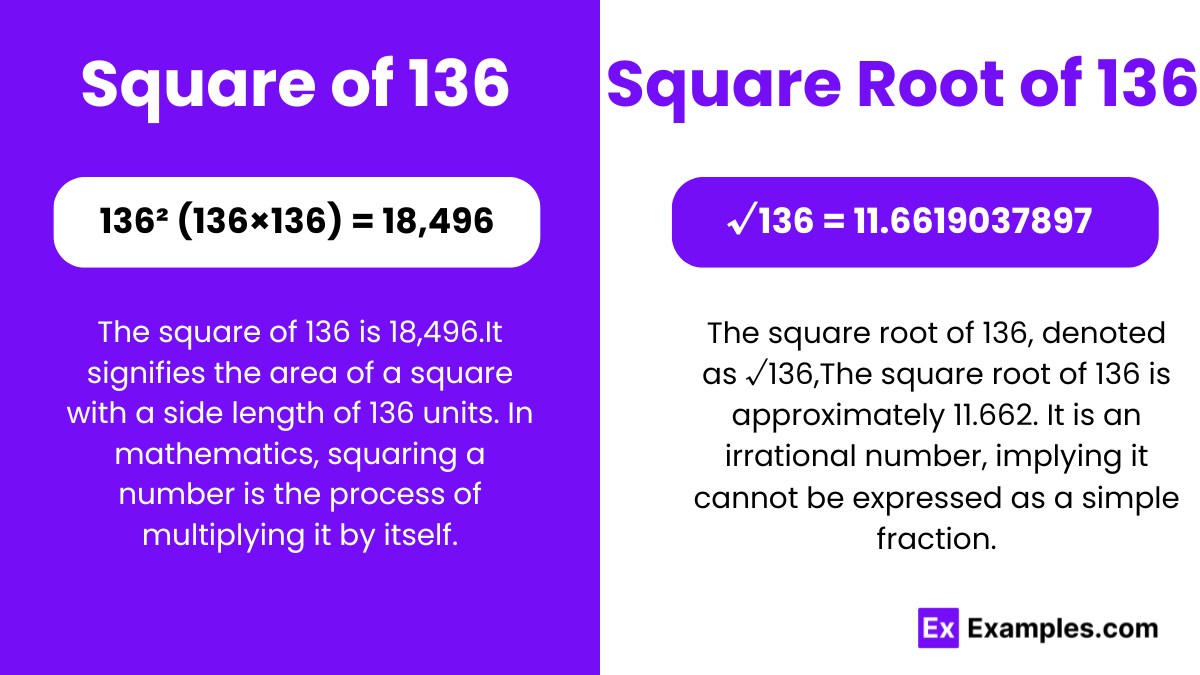What is the square of 136?
18,496
17,856
18,496
17,536


The square number of 136 is 18,496. This number represents the result of multiplying 136 by itself. It signifies the area of a square with a side length of 136 units. In mathematics, squaring a number is the process of multiplying it by itself.
√136 = 11.6619037897
Or
√136 = 11.661 up to three places of decimal
The square root of 136 is approximately 11.662. It is an irrational number, implying it cannot be expressed as a simple fraction.
Square Root of 136: 11.6619037897
Exponential Form: 136^½ or 136^0.5
Radical Form: √136
The square root of 136 is approximately 11.662. This means it cannot be expressed as a simple fraction or ratio of two integers. Its decimal expansion is non-repeating and non-terminating. The proof of its irrationality lies in its prime factorization, where 136 does not have a perfect square factor other than 1. Therefore, there is no integer that, when squared, equals 136. This property distinguishes it from rational numbers, which can be expressed as the quotient of two integers. The square root of 136 is a prime example of an irrational number in mathematics.
A rational number is any number that can be expressed as the quotient of two integers, where the denominator is not zero. It can be written in the form a/b, where a and b are integers.
Examples: 5/4,3/1
An irrational number is a real number that cannot be expressed as a simple fraction or ratio of two integers. Its decimal representation is non-repeating and non-terminating, making it impossible to express precisely as a fraction.
Examples: √2,√3.
There are several methods to find the value of the square root of 136:

Step 1: Write 136 as 136.000000. Now, look at the number in pairs from the right. “36” is a pair, while “1” stands alone.
Step 2: Find a quotient that matches the divisor. Multiply 1 by 1 to get 1. Then, subtract the result from 1.
Step 3: Double the quotient from step 2, which gives us 2. Now, the new divisor is 2x. Bring down “36” as a pair, making it the new dividend.
Step 4: Find a number for 2x times x that’s less than or equal to 36. We find 21 times 1 equals 21. Subtract this from 36 to get a remainder of 15.
Step 5: Place a decimal after the quotient “11” and bring down two zeros, making the dividend 1500. The new divisor is 11 times 2, which equals 22x.
Step 6: Find a number for 22x times x that’s less than or equal to 1500. We find 226 times 6 equals 1356. Subtract this from 1500 to get a remainder of 144.
Step 7: Repeat the process until we achieve three decimal places in the quotient.
No, because its Perfect square root is an irrational number, approximately equal to 11.662. A perfect square is the result of multiplying an integer by itself, and since 136 cannot be expressed in this form, it is not a perfect square.
To convert √135, you can use methods like prime factorization or estimation techniques to find an approximate value.
The factors of 136 are the numbers that can evenly divide into 136 without leaving a remainder. These factors include 1, 2, 4, 8, 17, 34, 68, and 136. In other words, 136 can be divided by each of these numbers without any remainder.
To find out what numbers 136 is divisible by, you can start by dividing 136 by small numbers, like 2, 3, 4, and so on, until you find one that divides evenly. If a number divides evenly, it means there’s no remainder. So, you keep trying until you find all the numbers that divide 136 without leaving any remainder.
The square root of 136 can be found by breaking it down into its prime factors: 2 × 2 × 2 × 17. Then, pairing the factors, we get 2 × √34, which is the simplest form of the square root of 136.
Text prompt
Add Tone
10 Examples of Public speaking
20 Examples of Gas lighting
What is the square of 136?
18,496
17,856
18,496
17,536
What is the approximate square root of 136?
11.66
11.67
11.68
11.69
Which of the following values is closest to the square root of 136?
11.6
11.7
11.8
11.9
If x is the square root of 136, then x is between:
11 and 12
12 and 13
10 and 11
13 and 14
Find the value of 136² − 136.
18368
18464
18304
18496
Which of the following is the closest integer value to the square root of 136?
12
10
13
11
What is √136 rounded to two decimal places?
11.67
11.66
11.68
11.69
Which of the following equations is true?
√136 =11.69
√136 =11.68
√136 =11.66
√136 =11.65
Solve for x: x² = 136
11.66
11.67
11.68
11.69
If y =√136, then y is closest to:
11.66
11.67
11.68
11.69
Before you leave, take our quick quiz to enhance your learning!

